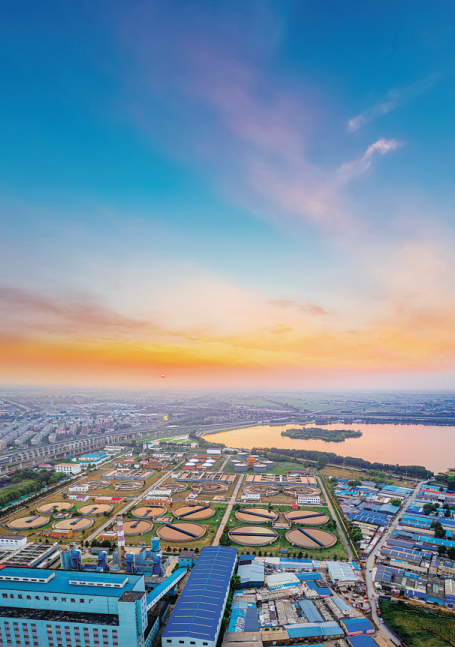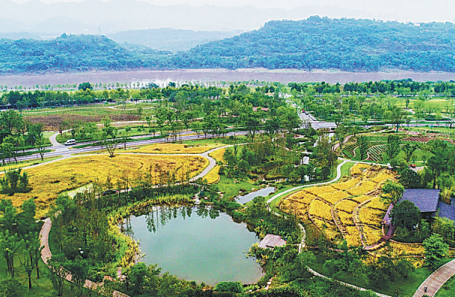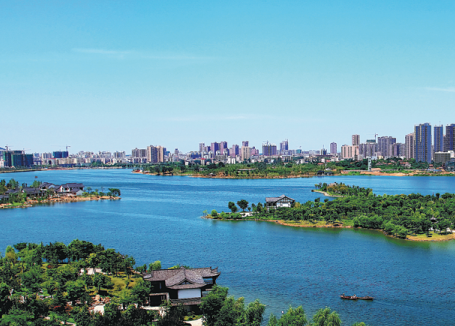State-owned financial institution is first in the country to join United Nations Global Compact
China Development Bank, with sustainability as one of its core values, has enhanced its financial services to boost the country's green development.
CDB has been committed to green growth and green finance. It's the first financial institution in China to join the United Nations Global Compact, an initiative that encourages businesses across the world to implement sustainability principles and social responsibility policies, a bank representative said.
The bank has expanded its loan offerings to environmental projects and green industries over the past few years.
Statistics from CDB showed that it made loans worth up to 292.2 billion yuan ($45.02 billion) to green industries in the first half of 2021.
The total balance of its green loans stood at 2.3 trillion yuan as of July, ranking first among domestic banks.
This year, CDB started with garbage and sewage treatment in rural areas to further step up its support for the country's green development.
In Taian, Shandong province, a major waste sorting project obtained loans of 2.45 billion yuan from CDB.
The project will cover the entire city, providing multiple services including garbage classification, transportation and treatment. More than 5.5 million local residents will benefit from the services, CDB said.
In addition, the bank financed Yan'an city in Shaanxi province to build the city's first underground sewage treatment plant.
With a daily treatment capacity of 15,000 metric tons, the plant will improve living conditions for 150,000 people.
In April, CDB launched an environmental protection campaign across the country. More than 100 counties were selected to receive loans totaling 100 billion yuan to construct advanced garbage and sewage treatment facilities.
By the end of June, the campaign had extended to 140 counties with loans of 46.6 billion yuan granted. About 1,000 counties will be reached by 2025 and social financing will amount to 1 trillion yuan, according to the bank.
The campaign is expected to give a new impetus to environmental management in rural areas, leading to more beautiful villages, a CDB executive said.
In response to the country's call for carbon peaking and carbon neutrality, CDB created a special loan of 500 billion yuan in June to help the country develop a safe and clean energy system during the 14th Five-Year Plan (2021-25).
CDB planned to lend 100 billion yuan in 2021 for allocation to key fields such as photovoltaic power generation and coastal nuclear power.
CDB also values forestry, which is a key aspect to achieving carbon neutrality. In Daning county, North China's Shanxi province, CDB distributed loans of 6.2 billion yuan to a local forestry poverty relief project.
The project includes transforming farmland into forests, restoring wasteland and planting nut trees. It will create 350,000 jobs for rural workers each year, local officials said.
CDB's aid not only promoted the local forestry industry but also helped rural people increase their income. By March this year, the forestry sector had received loans valued at 95.8 billion yuan from the bank.
"We have provided financing for planting 37,300-square-kilometer forests in 17 provinces, municipalities and autonomous regions around the country, which will increase timber reserves by 35 million cubic meters in the future," a CDB representative said.
Beyond credit, CDB has issued a host of green bonds, attracting social capital to bolster green development.
In March, the bank's first carbon-neutral bond was released with an issuance size of 20 billion yuan. All the money raised will flow into projects designed for emission reduction, especially such projects in the electric power industry, CDB said.
It is estimated that these projects will save more than 7.3 million tons of standard coal every year and cut emissions by about 19 million tons of carbon dioxide, 4,300 tons of sulfur dioxide and 4,700 tons of nitrogen oxides, according to CDB.
In addition, CDB issued bonds worth 10 billion yuan on July 16 to improve the environmental protection of the Yellow River and advance the high-quality development of regions along the river.
Also in July, another 10 billion yuan worth of bonds were launched to push forward the green growth of the Yangtze River Economic Belt. By issuing over-the-counter bonds at commercial banks, the financial institution has involved more people in green development.
CDB has issued renminbi-dominated green bonds of 90 billion yuan in total and underwritten 26 green bonds with total capital inputs of 31.8 billion yuan.
"We have also injected 8 billion yuan to the National Green Development Fund, which is jointly set up by the Ministry of Finance, the Ministry of Ecology and Environment and Shanghai municipality," a CDB representative said.
The capital was used mainly to be invested in fields such as green transportation and ecological restoration, according to operators of the fund.
As one of the main banks for China's foreign investment and financing cooperation, CDB embraced the green development philosophy when assisting in the Belt and Road Initiative.
For instance, the bank offered financing to the construction of Karot hydropower station in Pakistan, which is also the first large-scale hydropower project backed by the BRI. When completed, the power plant will generate 3.2 billion kWh of electricity and reduce 3.5 million tons of carbon emissions annually. It will effectively alleviate local power shortages and spur economic growth.
Since the BRI was launched, CDB has loaned more than $260 billion to projects linked to the initiative. At the Second Belt and Road Forum for International Cooperation held in 2019, CDB signed the Green Investment Principles for the Belt and Road, which 39 Chinese and foreign financial institutions have joined.
CDB is ready to work with all parties to promote green overseas investment related to the BRI and accelerate green transformation globally, a representative from the bank said. The bank also showed its willingness to share experience of sustainable development with the world. So far, it has organized 175 training sessions with hundreds of participants from 128 countries and regions.

China Development Bank contributes to the environment improvement of the Two Rivers, Four Lakes project in Guilin, Guangxi Zhuang autonomous region. CHINA DAILY

China Development Bank supports a series of sewage treatment projects in China. CHINA DAILY

The Changyang Island in Chongqing is a typical example of CDB's green development initiative. CHINA DAILY

CDB plays a key role in the natural preservation of the Yiai Lake in Huanggang, Hubei province. CHINA DAILY




 2015 All rights reserved
2015 All rights reserved